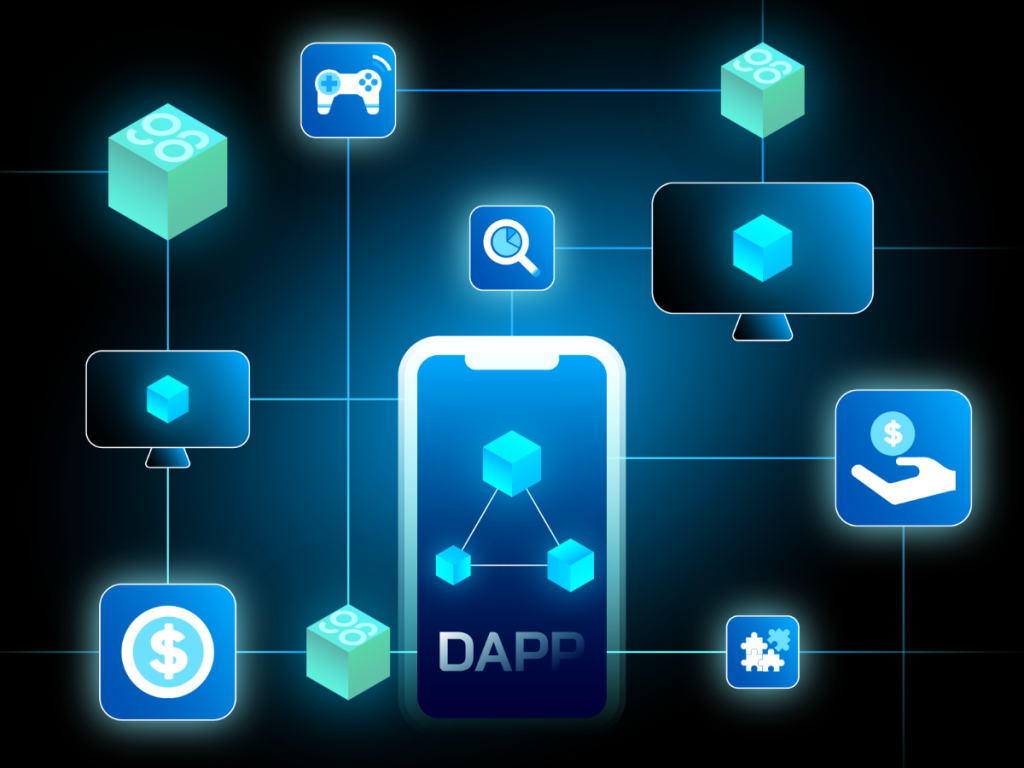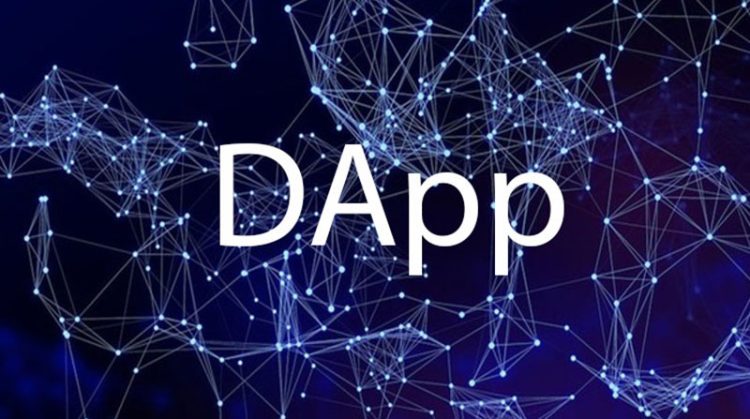Introduction
The rapid growth of blockchain technology has given rise to a new generation of applications known as Decentralized Applications (DApps). Unlike traditional centralized applications, DApps leverage the power of blockchain to operate in a decentralized, peer-to-peer manner, without the need for intermediaries. This shift in application design has the potential to transform traditional business models, challenging existing structures and offering new opportunities for innovation, transparency, and efficiency.
As businesses worldwide increasingly explore the potential of blockchain and DApps, it becomes evident that this technology is not just a passing trend—it represents a fundamental shift in how businesses can operate and interact with customers, suppliers, and other stakeholders. DApps promise to disrupt several industries, including finance, supply chain management, healthcare, and entertainment, by providing greater control, security, and transparency for users and organizations alike.
This article delves into the core features of DApps, explores how they are transforming traditional business models, and highlights the key benefits and challenges of adopting decentralized solutions.
1. What Are Decentralized Applications (DApps)?
1.1 Definition of DApps
A Decentralized Application (DApp) is an application that operates on a blockchain network or other decentralized platforms, rather than relying on a centralized server or authority. DApps typically function through smart contracts, which are self-executing contracts with the terms directly written into code and stored on the blockchain. These smart contracts govern the interaction between users and the application, without the need for a middleman.
1.2 Key Characteristics of DApps
- Decentralization: DApps are not controlled by any single entity. Instead, their data is distributed across a network of nodes, making them resistant to censorship and ensuring that no single party has control over the application.
- Open Source: Most DApps are open-source, meaning that the code is accessible to anyone and can be audited or modified by developers, fostering collaboration and innovation.
- Incentive Mechanism: DApps typically use cryptocurrencies or tokens to incentivize participants. These tokens can be used for various purposes, such as paying for services, rewarding users, or facilitating governance.
- Smart Contracts: DApps often rely on smart contracts to execute agreements automatically when certain conditions are met, ensuring trust and transparency without intermediaries.
1.3 Examples of DApps
- Finance (DeFi): Decentralized Finance (DeFi) applications like Uniswap, Aave, and Compound enable peer-to-peer lending, borrowing, and trading of cryptocurrencies without relying on traditional financial institutions.
- Gaming: CryptoKitties and other blockchain-based games allow players to own, trade, and interact with digital assets in a decentralized way.
- Social Networks: Platforms like Steemit offer decentralized alternatives to traditional social media networks, allowing users to earn tokens for content creation and curation.
- Supply Chain: DApps such as VeChain improve transparency and traceability in supply chains by recording every transaction and product movement on a blockchain.
2. How DApps Are Changing Traditional Business Models
2.1 Disintermediation: Eliminating Middlemen
One of the primary features of DApps is their ability to remove intermediaries—traditional third parties that facilitate transactions or provide services. In traditional business models, intermediaries like banks, payment processors, and regulatory bodies act as essential links in facilitating and securing transactions. However, intermediaries can introduce inefficiencies, increase costs, and create opportunities for fraud.
Example: In the finance sector, decentralized applications in DeFi (Decentralized Finance) are replacing traditional banks, brokers, and payment gateways. By using smart contracts, users can lend, borrow, and trade assets directly with each other without the need for a centralized authority. This reduces transaction costs and eliminates the delays associated with traditional banking systems.
Example: In insurance, DApps are being used to automate claims processing through smart contracts, where claims are verified and processed automatically, removing the need for insurance adjusters or claims agents. Companies like Etherisc are developing decentralized insurance platforms that operate on blockchain, allowing users to interact directly with the platform.
2.2 Enhanced Transparency and Trust
Traditional business models often rely on centralized data repositories that are prone to manipulation, fraud, or error. DApps leverage blockchain’s immutability and transparency to ensure that all transactions and data are securely recorded and cannot be altered once written to the blockchain. This creates a higher level of trust between parties, as all participants can access the same information and verify transactions independently.
Example: Supply chain management benefits significantly from DApps. Platforms like VeChain use blockchain to record every transaction and product movement, making it easy to trace the origins of goods, verify product authenticity, and ensure compliance with safety standards. This level of transparency can significantly reduce fraud, counterfeiting, and inefficiencies in global supply chains.
2.3 Improved Data Ownership and Privacy
In traditional business models, companies often control the data generated by their customers, employees, and suppliers. This raises concerns about data privacy, security, and ownership. DApps provide a more user-centric approach by allowing individuals to retain ownership of their data. Users can control access to their data and even monetize it, creating new opportunities for privacy-focused business models.
Example: Brave, a decentralized web browser, rewards users with the Basic Attention Token (BAT) for viewing ads while simultaneously protecting their privacy by not tracking their activity. Users can choose to share their data with advertisers in exchange for rewards, giving them control over how their information is used.
2.4 Decentralized Governance and Tokenization
Traditional businesses are typically governed by a central authority, such as a CEO, board of directors, or government regulators. DApps, however, often introduce decentralized governance models through Decentralized Autonomous Organizations (DAOs). DAOs enable stakeholders (such as token holders or users) to participate in the decision-making process, allowing for a more democratic and transparent approach to governance.
Example: MakerDAO, a decentralized platform for creating and managing stablecoins, is governed by its token holders. Decisions regarding the platform’s protocols and policies are made through a voting system, allowing participants to have a say in the platform’s future. This is a departure from traditional centralized companies, where decisions are typically made by a small group of executives or shareholders.
Moreover, tokenization—the process of converting assets or services into digital tokens on a blockchain—has opened up new ways for businesses to raise capital, engage customers, and incentivize participation. Through Initial Coin Offerings (ICOs), Security Token Offerings (STOs), or Non-Fungible Tokens (NFTs), companies can create new business models that engage users and investors directly.
Example: The rise of NFTs has revolutionized the art industry. Artists can tokenize their work as NFTs, providing a new revenue stream and ensuring that their creations are verifiably unique and tradable on decentralized platforms. This cuts out traditional intermediaries such as galleries or auction houses, giving artists greater control over their sales and royalties.
3. Key Benefits of DApps for Traditional Businesses
3.1 Reduced Costs and Increased Efficiency
By eliminating intermediaries, automating processes, and leveraging the decentralized nature of blockchain, DApps can drastically reduce operational costs and increase efficiency. For example, in the financial sector, by using decentralized lending platforms or exchanges, transaction fees can be minimized, and settlement times can be reduced from days to minutes.
3.2 Global Accessibility
DApps are inherently global, as they operate on public blockchains that are accessible to anyone with an internet connection. This opens up new business opportunities in regions with limited access to traditional banking and financial services. Blockchain-based remittances, for example, allow individuals to send money across borders at lower costs and without the need for traditional banking services.
3.3 Security and Fraud Prevention
The immutability of blockchain, combined with the use of cryptographic techniques, makes DApps inherently more secure than traditional centralized systems. Data breaches, fraud, and tampering with records are much more difficult to carry out in a decentralized environment.
Example: In the voting system, DApps can be used to create transparent, tamper-proof election processes. Voters can cast their ballots using secure digital identities, and every vote can be recorded on the blockchain, ensuring the integrity and transparency of the election process.
3.4 Fostering Innovation
DApps promote innovation by encouraging a more open and collaborative approach to development. The open-source nature of most DApps allows developers to contribute and improve upon existing systems, leading to rapid advancements in technology and new business ideas.
Example: The DeFi sector is a prime example of how DApps can drive innovation. New financial services—such as decentralized lending, yield farming, and liquidity pools—are rapidly evolving as developers build on existing protocols. This innovation is creating more accessible, efficient, and decentralized alternatives to traditional banking services.

4. Challenges and Considerations for Businesses Adopting DApps
While DApps offer numerous benefits, their adoption presents several challenges:
4.1 Scalability and Performance
Blockchain networks, particularly public blockchains, can struggle with scalability. As the number of users and transactions increases, network congestion can lead to slower transaction speeds and higher fees. Businesses must carefully consider the scalability of the underlying blockchain when adopting DApps.
4.2 Regulatory Uncertainty
As DApps operate in a decentralized and often
pseudonymous manner, they can present challenges for regulators. Governments and regulatory bodies are still working to establish frameworks for managing decentralized technologies, and businesses may face legal uncertainty when operating with DApps.
4.3 User Adoption
While blockchain and DApps are gaining popularity, many users are still unfamiliar with these technologies. Businesses must invest in educating users and providing intuitive user interfaces to encourage adoption.
Conclusion
Decentralized Applications (DApps) are revolutionizing the way businesses operate by offering alternatives to traditional business models that rely on centralized intermediaries. With the ability to eliminate middlemen, enhance transparency, improve data privacy, and enable decentralized governance, DApps are poised to disrupt various industries, including finance, supply chain, healthcare, and entertainment.
Although the adoption of DApps presents certain challenges, such as scalability, regulatory uncertainty, and user adoption, the potential benefits—such as reduced costs, increased efficiency, and enhanced security—make DApps an attractive proposition for businesses looking to innovate and stay competitive in an increasingly decentralized world.
As blockchain technology continues to evolve, the impact of DApps on traditional business models will only grow, opening up new opportunities for collaboration, efficiency, and trust in the digital age. Businesses that embrace these decentralized solutions will be well-positioned to lead in the next wave of technological innovation.
















































